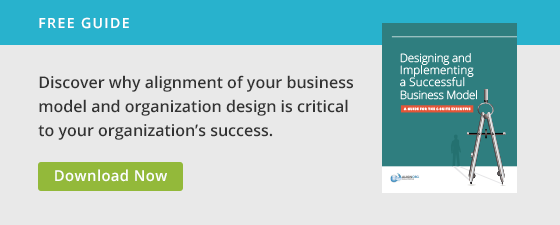In today’s highly competitive global market, companies rise and fall faster than ever before. Motorola, Eastman Kodak, and Blockbuster are examples of well-recognized brands that were once market leaders in their respective industries. These companies were known for being innovative and capitalizing on market opportunities. All of that changed when they lost sight of emerging trends and failed to make the necessary changes to their strategies, operations and organization designs to stay on top. If key executives in these companies paid attention to what was happening around them, they might still be market leaders today.
The role of leadership is to focus on key performance indicators and external trends to determine when to change their organization design or business model. There are many signals that it may be time to consider implementing a change to your organization design but in our experience the following are the most common:
- Something in the marketplace has changed and your organization design is no longer a fit for the purpose of the customer or market you are going after.
If something in the business marketplace changes, by design or default, your organization design may have to change as well. Motorola, the first company to build and sell a mobile phone in the world dominated the market in 2003 with its trendy RAZR phone. But it failed to see the demand for a smartphone at the time and lost market share to Apple, LG and Samsung. Motorola went through numerous changes in its strategy and organization design to re-claim its position as a market leader – spinning off its mobile division as Motorola Mobility, selling it to Google and introducing the Android, to name a few.
- You can no longer differentiate your company in the market.
Companies with an innovative product or unique service can typically differentiate themselves in the market. However, over the course of the product or service life cycle, that unique selling point may become obsolete due to market saturation, competitive offerings, or other reasons unless the company intervenes. For example, a new feature or supplemental product/service could be added. Disney once required guests to purchase refreshments separately from a theme park admission and lodging package. It now offers pre-paid food, lodging and entertainment packages to simplify and enrich the experience for its guests.Adding to an offering usually requires implementing an organization change. In Disney’s case, food service was an independent profit center so it had to change that to give it the opportunity to add value to the services offered to its guests.
- You need to become more efficient and/or productive to remain competitive.
As highlighted in the book “Unleashing the Killer App: Digital Strategies for Market Dominance” by Larry Downes and Chunka Mui, every so often a company comes along that revolutionizes business processes which requires other companies to do the same. When Amazon figured out online retailing and its supply chain, the competition was basically crushed. Amazon made it almost cost prohibitive for other online retailers to compete. Its organization design caused change transformation in an entire industry.
Other warning signs that a company needs to change its organization design include: a reduction in profits and market share, lack of innovation, slow growth, misalignment of expenses compared to competitive expenditures in R&D, marketing and other areas; as well as product/service commoditization. Any one of these factors can indicate that it is time for a new organization design.
The strategic impact of an organization design change can be tremendous for a company. Hyundai added a warranty to its new car package that was superior to any program offered by its competitors this helped to launch its brand in the U.S. Prior to offering this warranty U.S. consumers had concerns about the quality of Hyundai cars which resulted in low market acceptance. Without this organization change Hyundai may not have been accepted in the competitive U.S. market.
Eastman Kodak, on the other hand, did not respond quickly enough to the demand for digital photography despite inventing the core technology used in digital cameras, this resulted in the company filing for Chapter 11 in 2012. Blockbuster had nearly 60,000 employees and over 9,000 stores at its peak then in 2004 consumers started streaming video instead of renting. Blockbuster failed to adjust to meet consumer demands and subsequently filed for Chapter 11. These examples may seem extreme but they illustrate the fact that successful companies must be vigilant of market changes and willing to adjust their organization design as needed to meet market demands and to remain relevant.

